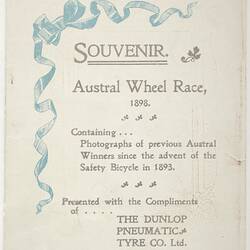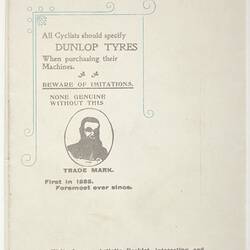Summary
Souvenir booklet for the 1898 Austral Wheel Race representing one of the major sporting and cultural events in Melbourne in the late nineteenth century.
The Austral Wheel Race was first held in 1887. It was arranged by the Melbourne Bicycle Club, at that time the longest established cycling club in Australia, and run on the grass at the Melbourne Cricket Ground on high wheel [penny farthing] bicycles. The prize was apparently a walnut cabinet containing 152 pieces of silver and cutlery valued at 200 pounds sterling. By the 1890s the Austral Wheel Race was the most valuable cycle race in the world and attracted cyclists from around the world. In 1901 the race fell into disrepute when after the American entrant 'Plugger' Bill Martin won the race from scratch, there were claims of race fixing involving notorious Melbourne identity, John Wren. The race has been run continuously on an annual basis since its inception. The race held in March 2008 was at Vodafone Arena at Melbourne Park. Other venues have included the Royal Exhibition Building grounds, Olympic Park, the Brunswick, Coburg and Northcote velodromes, and Melbourne Park.
Description of Content
This document contains photographic portrait images of the winners of the Austral Wheel Race, posed on their bicycles: G. Woodward (1893), A.A. Middleton (1894), A.B. Crisp (1895), C.B. Kellow (1896) and J. Carpenter (1897).
Physical Description
Folding booklet with silver printed text. Contains portraits within silver borders.
Significance
This souvenir booklet for the 1898 Austral Wheel Race celebrates Australia's most famous and most valuable cycle race in the late nineteenth century. Containing photographs of previous Austral Wheel champions since the introduction of the safety bicycle to the race in 1893, the booklet highlights the increased popularity of the race during the late 1890s period when the safety bicycle had replaced the high wheel [penny farthing] bicycle. Produced by Dunlop Pneumatic Tyre Co, a leading manufacturer of bicycle tyres who advertised extensively, the booklet also highlights the industry behind cycling. Melbourne was the cycling capital of Australia in the late nineteenth century, and this booklet reminds us of the importance of the Austral Wheel Race in both Australia and Melbourne's sporting and cultural life in this period. By the 1890s, tens of thousands of spectators, including many women, would turn out for this race each year. This booklet is thus historically and culturally significant as an artefact of a key event in Melbourne's history.
More Information
-
Collection Names
-
Collecting Areas
-
Acquisition Information
Purchase
-
Publisher
Dunlop Pneumatic Tyre Company, Melbourne, Victoria, Australia, 1898
-
Inscriptions
Printed, front in silver ink: "SOUVENIR / Austral Wheel Race 1898 / Containing ... Prhotographs of previous Austral Winners since the advent of the Safety Bicycle in 1893 / Presented with Compliments of ... THE DUNLOP PNEUMATIC TYRE CO. Ltd. / 247 Swanston St. Melbourne."
-
Classification
-
Category
-
Discipline
-
Type of item
-
Overall Dimensions - Folded
93 mm (Width), 115 mm (Height)
-
Keywords




